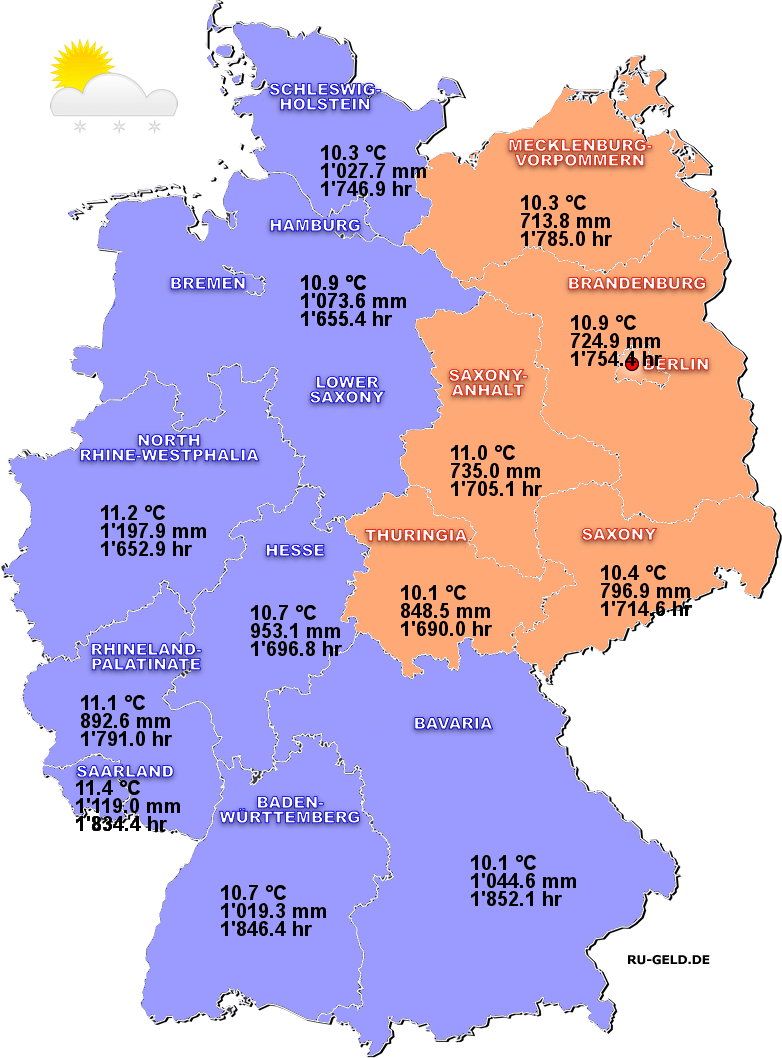Climate in Germany: characteristics and peculiar features of the climate, climate region/ belt and zones, climate map of Germany, climate change
§ Climatic zones or climate belts of Germany
Climate is a permanent state of weather conditions, recurring each and every year, embracing atmospheric pressure, precipitation, air temperature, atmospheric circulation, and some other characteristics. The climate of the Earth is usually divided into zones (in German: Klimagürtel or Klimazonen), the said zones or belts gird the Earth from east to west and are located one below the other. This division occurs due to the fact that the position and movement of the Planet, as well as the inclination of the Earth, determine the receipt of different amounts of sunshine in different latitudes of the Earth. So, the Earth has several climatic zones from the north and south towards the equator: polar, subpolar, temperate, subtropical, and tropical (there are different classifications as well).
Germany is located in the temperate climatic zone, in its warmer part.
Germany is entirely located in the temperate climatic zone, more precisely, in the warmer part of the temperate zone (in German: kühlgemäßigte Klima). It is located between 47 and 55 degrees of latitude, and 6 and 15 degrees of longitude. A large difference in temperatures at different times of the year (winter and summer) is typical of the temperate zone, although this difference decreases towards the equator. This climatic zone hosts mixed forests, with more deciduous forests equatorwards, and coniferous - towards the pole. These latitudes have different lengths of day and night (sunrise-to-sunset and sunset-to-sunrise) during the year; they have distinctive seasonal changes, variable weather and quite a lot of rainfall. The temperate climate belt is characterized by predominant westerly winds (direction from west to east), (in German: Westwindzone); the winds blow stronger in winter and gentler in summer.
§ German climate characteristics, peculiar features
Depending on the terrain and other factors, climatic zones are subdivided by different types of climate. In the temperate zone, according to different classifications, several of the following types of climate are distinguished: marine or oceanic climate, intracontinental climate, mediterranean, subtropical mountain, and monsoon climate types.
Most of Germany has the oceanic climate characterized by a west-to-east transition from the maritime climate to the continental one.
Germany is mostly characterized by an oceanic climate, it is formed under the influence of the Atlantic Ocean and the Gulf Stream; it has warm summers, 10-20 degrees Celsius, and warm winters, 0 degrees Celsius, and a relatively large amount of rainfall. The country is characterized by a west-to-east transition from the Western European maritime climate to the Eastern European continental climate.
However, due to the fact that Germany has different landscapes: the coasts of the seas, lowlands and hills, as well as mountain ranges (read more at the geographical location and landscapes of Germany), the climate across the country varies accordingly in different regions.
The climate of the northern part of the country is affected by the North and Baltic Seas, washing the northern coast of Germany. The influence of the seas makes the climate in the North German Plain or Northern Lowland marine with rainy summers, warm winters and storms. In the east and southeast there is a continental climate with hotter summers and cold winters. In the very south in the Alpine mountains there is a typical mountain climate. Although there are typical climate differences between the northern, western, and eastern parts of Germany, there are exceptions to the weather type.
In Germany, consecutive extreme weather events are quite rare, yet, there are periods of intense heat, storms, thunderstorms and tornadoes, droughts and floods.
Average air temperatures, amount of rainfall/ precipitation and number of sunny days
As of 2023 the average annual air temperature in Germany is 10.6°C.
As of 2023, the average annual air temperature in Germany was 10.6 °C. The coldest month in Germany is January, while the warmest one is July. In the same year in Germany there was an average of 1'753 hours of sunshine, and the amount of precipitation was 958 liters per 1 square meter.
Table 1. Average temperatures, the number of sunny days and amount of precipitation in Germany by federated state as of 2023.
| Federated state | Average annual temperature, degrees Celsius | Number of hours when the sun shone, hours | The amount of precipitation, liters per square meter |
|---|---|---|---|
| Baden-Württemberg | 10.7 °C | 1'846 h | 1'019 l/m2 |
| Bavaria | 10.1 °C | 1'852 h | 1'045 l/m2 |
| Berlin | 10.9 °C | 1'754 h | 725 l/m2 |
| Brandenburg | 10.9 °C | 1'753 h | 723 l/m2 |
| Bremen | 10.9 °C | 1'655 h | 1'074 l/m2 |
| Hamburg | 10.9 °C | 1'655 h | 1'074 l/m2 |
| Hesse | 10.7 °C | 1'697 h | 953 l/m2 |
| Mecklenburg-Vorpommern | 10.3 °C | 1'785 h | 714 l/m2 |
| Lower Saxony | 10.9 °C | 1'654 h | 1'074 l/m2 |
| North Rhine-Westphalia | 11.2 °C | 1'653 h | 1'198 l/m2 |
| Rhineland-Palatinate | 11.1 °C | 1'791 h | 893 l/m2 |
| Saarland | 11.4 °C | 1'834 h | 1'119 l/m2 |
| Saxony | 10.4 °C | 1'715 h | 797 l/m2 |
| Saxony-Anhalt | 11.0 °C | 1'705 h | 735 l/m2 |
| Schleswig-Holstein | 10.3 °C | 1'747 h | 1'028 l/m2 |
| Thuringia | 10.1 °C | 1'690 h | 849 l/m2 |
For more information about average annual temperatures, as well as about the number of sunny days and the amount of precipitation, see dedicated pages of our website.
Average air temperature in Germany by month, by year, by federated state
On this page of our website you will find detailed information about average air temperatures in the country: average annual temperature by year, as well as air temperature by season: winter, summer, spring and autumn. Besides, the pages contain maps featuring the average temperature around the country by federated state or region.
- Average annual air temperature in Germany
- Average monthly temperature in Germany
- Average temperature in Germany by year
- Average temperature in Germany by federated state
- Temperature in Germany in winter in December, January, February
- Temperature in Germany in summer in June, July, August
- Temperature in Germany in autumn in September, October, November
- Temperature in Germany in spring in March, April, May
Rainfall in Germany by season, month and annual average by year
This page of our website provides information on the amount of precipitation in the country: you will learn how precipitation is measured, as well as what the indicators of precipitation are, with monthly variations over the year, changes by year and by federated state.
- Annual rainfall in Germany
- Measurement, counting rainfall data
- Precipitation in Germany by month
- Precipitation in Germany by year and season
- Precipitation in Germany by federated state
The number of sunny days in Germany by federated state, by year, season and month
Here is information about the sunshine hours quantity and number of sunny days in the country: you will learn how the quantity of hours of sunshine is measured, and also what the indicators of sunshine are, with monthly variations over the year, changes by year and by federated state.
- Number of sunny days in Germany
- How to measure the number of hours and days of sunshine
- Sunny days in Germany by month
- Sunny days in Germany by year and season
- Sunny days in Germany by federated state
§ Climatic map of Germany
Based on the above data presented in Table 1, below you will find a climatic map for the federated states of Germany; it offers a clearer visual representation of the climate throughout the regions of the country.
Climatic map of Germany as of 2023.

§ Climate change in Germany
As around the world, in recent years Germany has witnessed a gradual increase in average annual air temperatures. The German Meteorological Service, aka the German Weather Service (DWD) has been registering various weather indicators throughout the country for more than 100 years, since 1881. According to the German Meteorological Service, over the past more than 100 years, the average air temperature in Germany has risen by 1.4 degrees Celsius. In this regard, the number of warm and hot days has increased and the number of cold days in the year has decreased, from year to year spring begins earlier. Besides, the annual rainfall has increased, especially in winter and spring, by about 9%. The sea level in the country has also risen by 20 cm in the German Bight and by 14 cm in the Eastern (Baltic) Sea.
Over the past more than 100 years, the average air temperature in Germany has risen by 1.4 degrees Celsius.
Due to the longer warm period during the year, changes in the time of bird migration occur, the pollen season is longer, changes in the animal population also take place. According to the results of a study published in the PLOS ONE journal in 2017, the number of flying insects in Germany has dramatically fallen, over the past 27 years their total amount has decreased by 76-82%. Although the study does not indicate any specific causes of the insects extinction, climate change may be one of the reasons for this fact. It is not surprising that one of the goals in the German domestic policy for 2019-2021 includes, among other issues, the insects extinction prevention.
According to the data published by the Federal Environment Agency (in German: Umweltbundesamt Deutschlands), the effects of climate change in the country will be felt more and more: the risk of floods, rainfall in winter and periods of intense heat and drought in summer will increase, more storms are expected on the sea coasts. The German government signed the "Climate Change Adaptation Strategy", document, which outlines 13 areas where climate change impacts are felt and offers adaptation options. These areas include: agriculture, forestry, fisheries, biodiversity, construction, healthcare, transport and transportation infrastructure, water balance, water management, marine protection, soil, tourism, industry, trade, energy and finance.
Information sources
RU-GELD.DE Team
Last updated:

Climate in Germany: zones, map, characteristics, change
- Information about Germany
- All about Germany and the Germans - a general description of the country
- Administrative and territorial structure of Germany
- National symbols of Germany: flag, coat of arms, anthem, buildings, mottos and others
- Federated states of Germany and their capitals in German and English
- Political structure of Germany: parties, elections, authorities, policy
- Germany budget: structure, revenues and expenditures
- Climate and weather in Germany
- List of all German cities ordered alphabetically in English and German
- Related topics:
- Average air temperature in Germany
- Precipitation in Germany, annual average by year
- Number of sunny days in Germany
- Temperature in Germany in winter
- Temperature in Germany in summer
- Temperature in Germany in autumn
- Temperature in Germany in spring